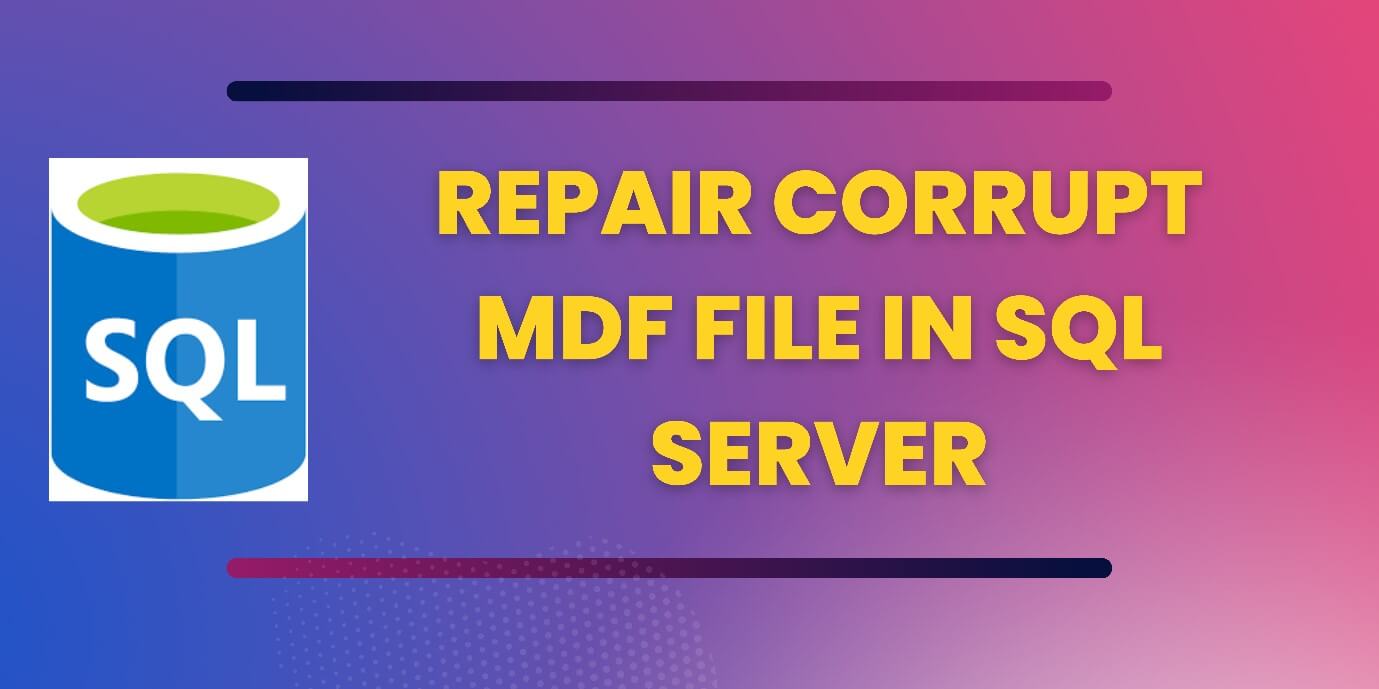Updated July 17, 2023
How to Repair Corrupt MDF File in SQL Server?
MDF file in SQL Server stores automated database information such as tables, functions, triggers, indexes, etc., along with the schema information. It is also known as the primary database file.
Despite having countless exceptional features, users still face MDF file corruption due to unexpected causes like abrupt shutdown, virus attacks, etc. Regardless of the reasons, one can fix the issue easily with proper & correct guidance.
Thus, if you also face MDF file corruption, read this post and apply the approaches mentioned here. You should also know how to restore the database from the MDF file in SQL Server.
Reason for Corruption of MDF File in SQL Server
Before taking action to repair the MDF file SQL server, know the possible reasons that can trigger MDF file corruption.
- Due to file header corruption.
- Network failure or power outage.
- When the SQL database file (MDF) is saved in the compressed folder.
- Virus attack on a server.
- Disk drivers or controllers-related issues.
- The SQL Server account is modified.
- Using the outdated version of Windows OS or SQL Server.
- Software glitches.
Manual Methods to Repair a Corrupt MDF File in SQL Server Database
Method 1- Repair/Recover Corrupted MDF File
- Users should regularly create a valid backup of their essential MDF and NDF files.
- Thus, in case anything goes wrong, they can easily get them back instead of repairing them.
- Therefore, if you have a backup, try to recover it from a backup instead of fixing the corrupt .mdf file.
- Try method 2 to fix the MDF corruption issue without a backup.
Method 2- How to Repair Corrupt MDF File Using DBCC CHECKDB
- Another method to troubleshoot the MDF database file corruption is to run the DBCC CHECKDB in Microsoft SQL.
- Running this command helps to check the logical & physical integrity of tables, functions, triggers, and other objects in SQL databases along with fixing the file corruption issue.
Follow these Steps and Run the DBCC CHECKDB to Get Rid of the Issue:
Step 1-
- Simply run the DBCC CHECKDB command on a corrupted SQL database by using the below command,
DBCC CHECKDB (Name of the corrupt Database)
Step 2-
- In addition, check an index ID & consider the below 2 situations accordingly.
- Situation 1- If the Index ID is greater than 1, drop the ID and create it once again.
- Situation 2- If the Index ID is 0 or 1, run DBCC CHECKDB using repair_allow_data_loss, repair_rebuild, or
For instance,
DBCC CHECK (name_of_corrupt_database, repair_allow_data_loss)
DBCC CHECK (name_of_corrupt_database, repair_fast)
DBCC CHECK (name_of_corrupt_database, repair_rebuild)
Step 3-
- At last, you have to rerun the DBCC CHECKDB to confirm that the corruption issue is solved.
Note: Running the DBCC CHECKDB repair_allow_data_loss command can lead to data loss. So, it is better to try the automated solution.
Limitations of Manual Workarounds
- Manual workarounds are much more time-consuming.
- It does not offer a 100% success rate of file repair.
- Applying the manuals can sometimes lead to complete data loss.
- Sometimes, it requires the individual to have advanced technical skills.
- Manual techniques are not very effective.
What to do in Case Manual Methods Fails to Repair Corrupt MDF File?
- If manual methods fail to repair the MDF file in SQL server, try the proficient tool- Stellar Repair for MS SQL.
- It can repair severely corrupt MDF and NDF files successfully and recover inaccessible objects such as tables, triggers, keys, indexes, defaults, and rules.
- The best part about this SQL Recovery software is it’s a safe, secure, and easy-to-use program. You can even use this feature-loaded utility without having any advanced or technical knowledge.
- You can download & install Stellar Repair for MS SQL on your PC & follow the below step-by-step guide to learn how this tool works.
Steps to Repair Corrupted MDF File by Using Stellar Repair for MS SQL
Step 1: First, browse the corrupted MDF file on your computer.
Step 2: After selecting the corrupted SQL database .mdf file, click on the Repair option.
Step 3: After that, choose the correct scan mode for repairing the database .mdf file and click on the OK option.
Step 4: Now, the program displays the progress of the SQL database repairing process.
Step 5: When the process is over, click on the OK button.
Step 6: Once the software shows the preview of the repaired file, go to the File menu & click on the Save option.
Step 7: Choose an option to save your repaired SQL (MDF) file and click Next to proceed.
Step 8: Enter the required details to connect to SQL Server and save the fixed MDF database file. Once done, click the Next option.
Step 9: Choose a proper file saving mode and click Save to confirm.
Step 10: The program displays the progress of saving the filing process as Pending, Processing, Aborted, or Completed.
Step 11: Finally, you will get the confirmation message on your screen once the file-saving process is complete.
Conclusion
MDF file corruption situation restricts MS SQL users from accessing their data. Thus, the three different workable solutions to repair the MDF file SQL server effortlessly will be beneficial. However, use Stellar Repair for MS SQL to tackle this situation risk-free. Its advanced utility will help repair corrupt MDF files with less effort.



